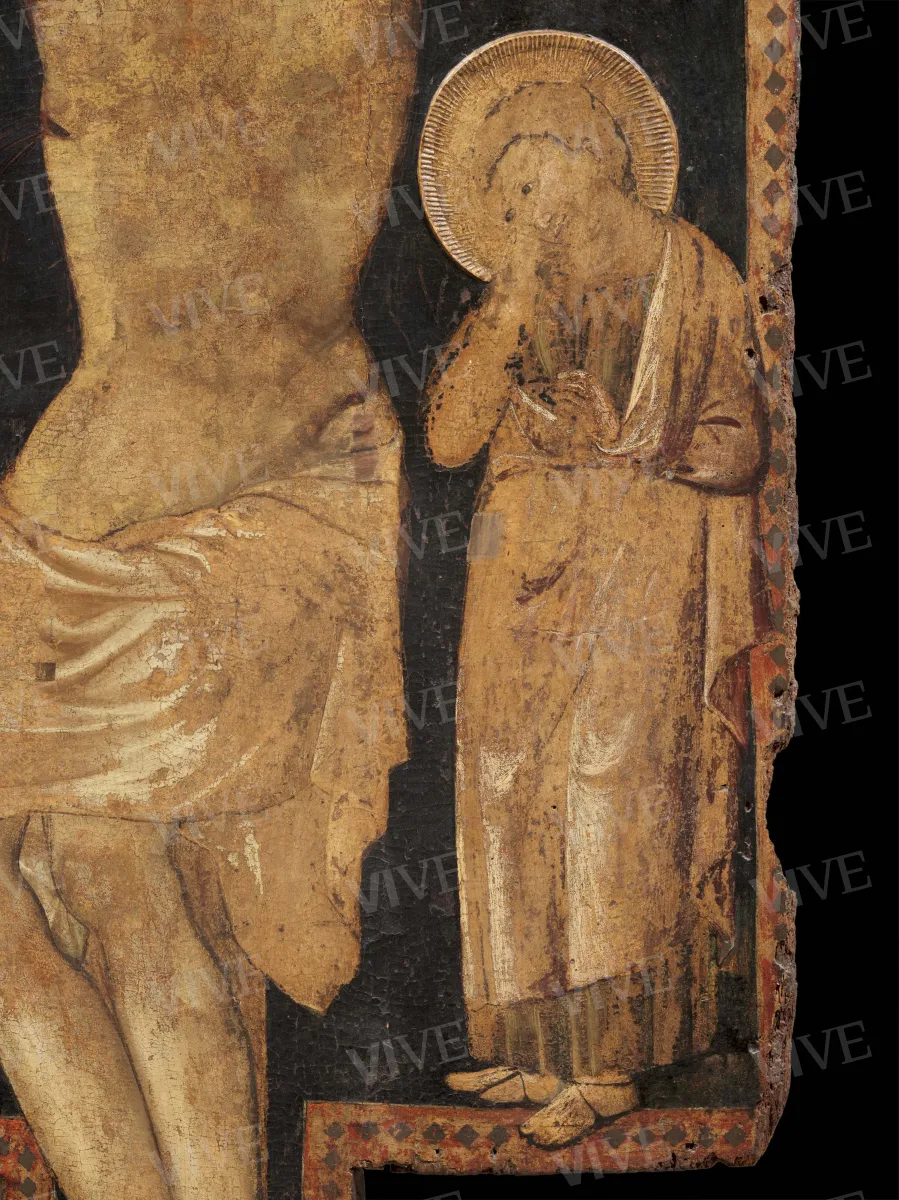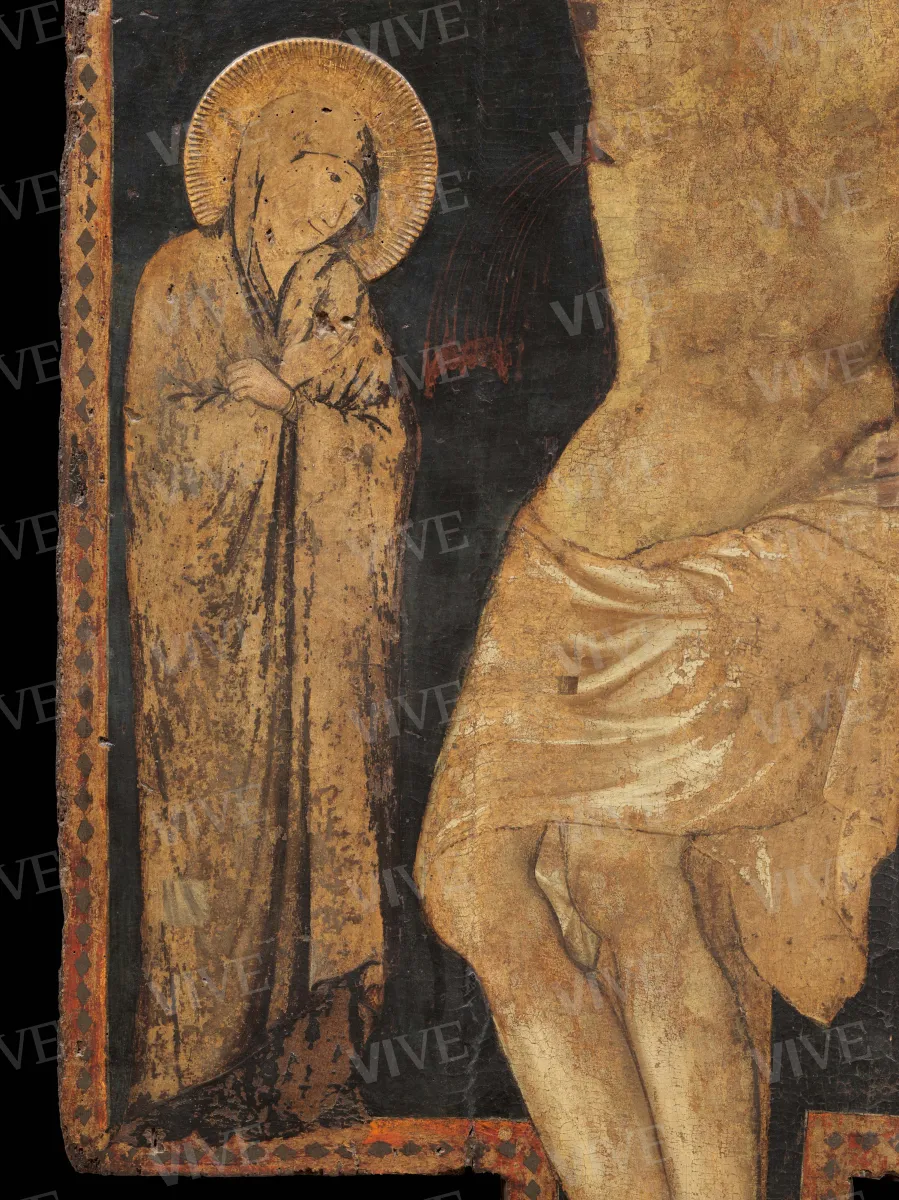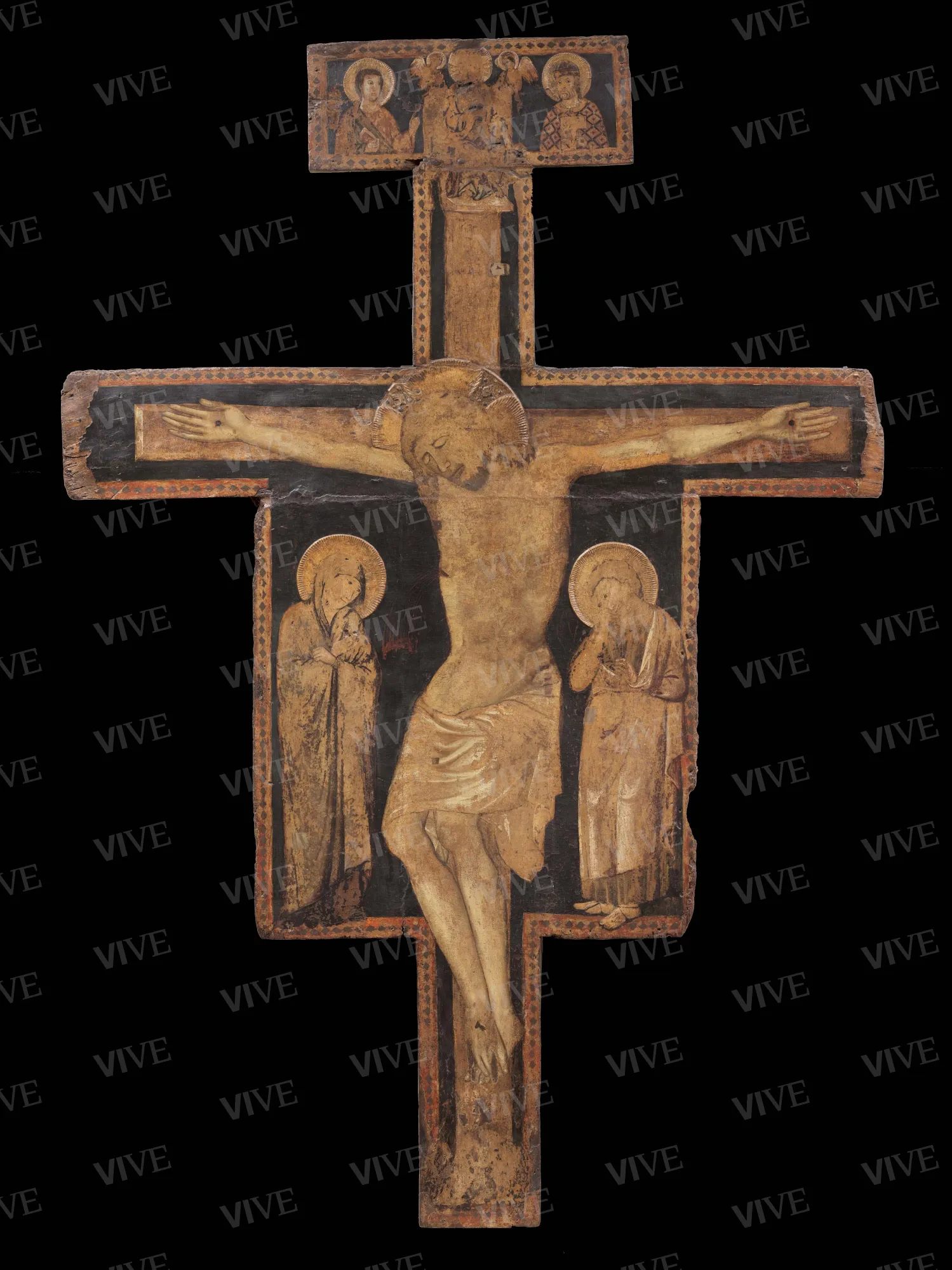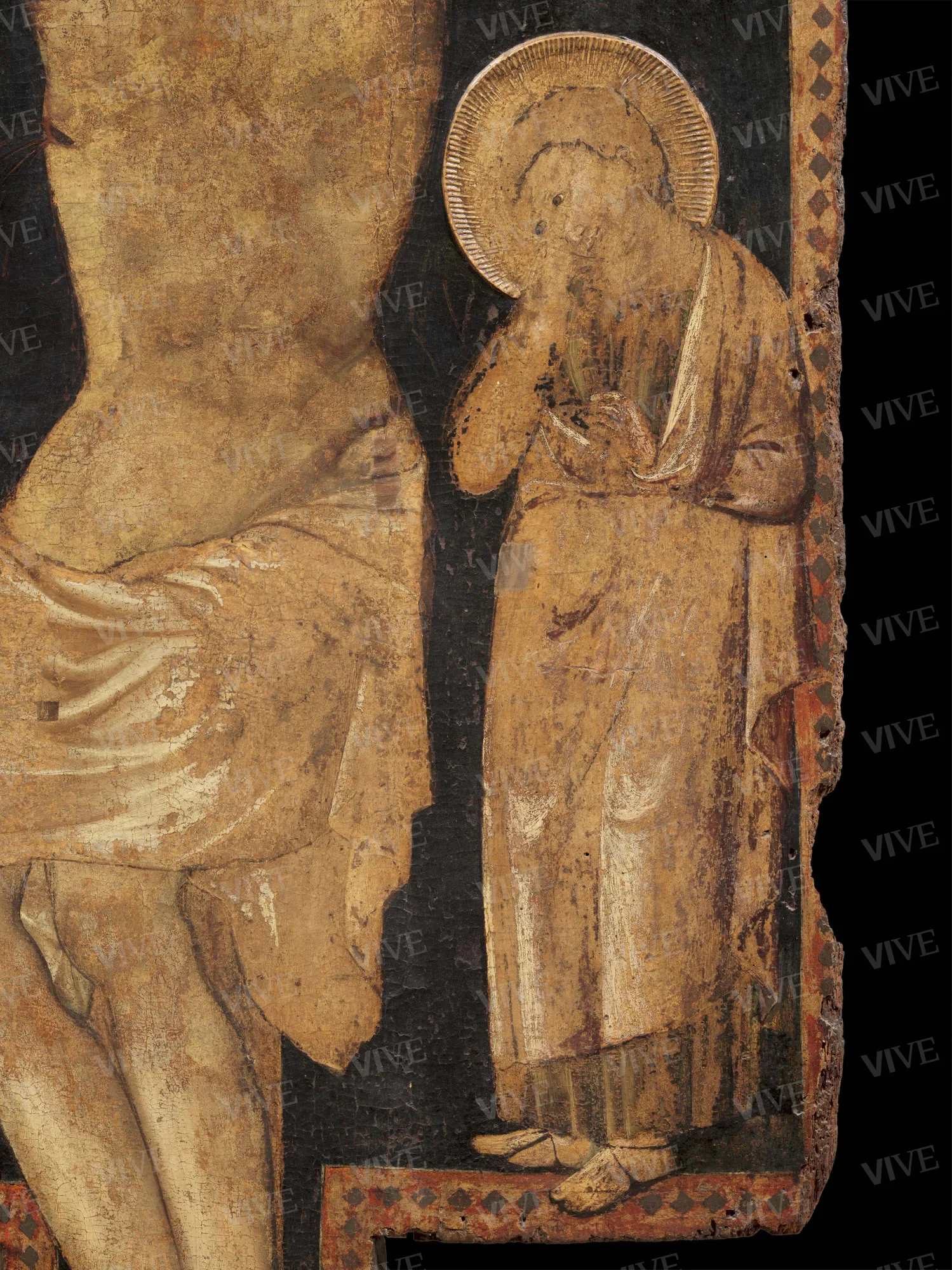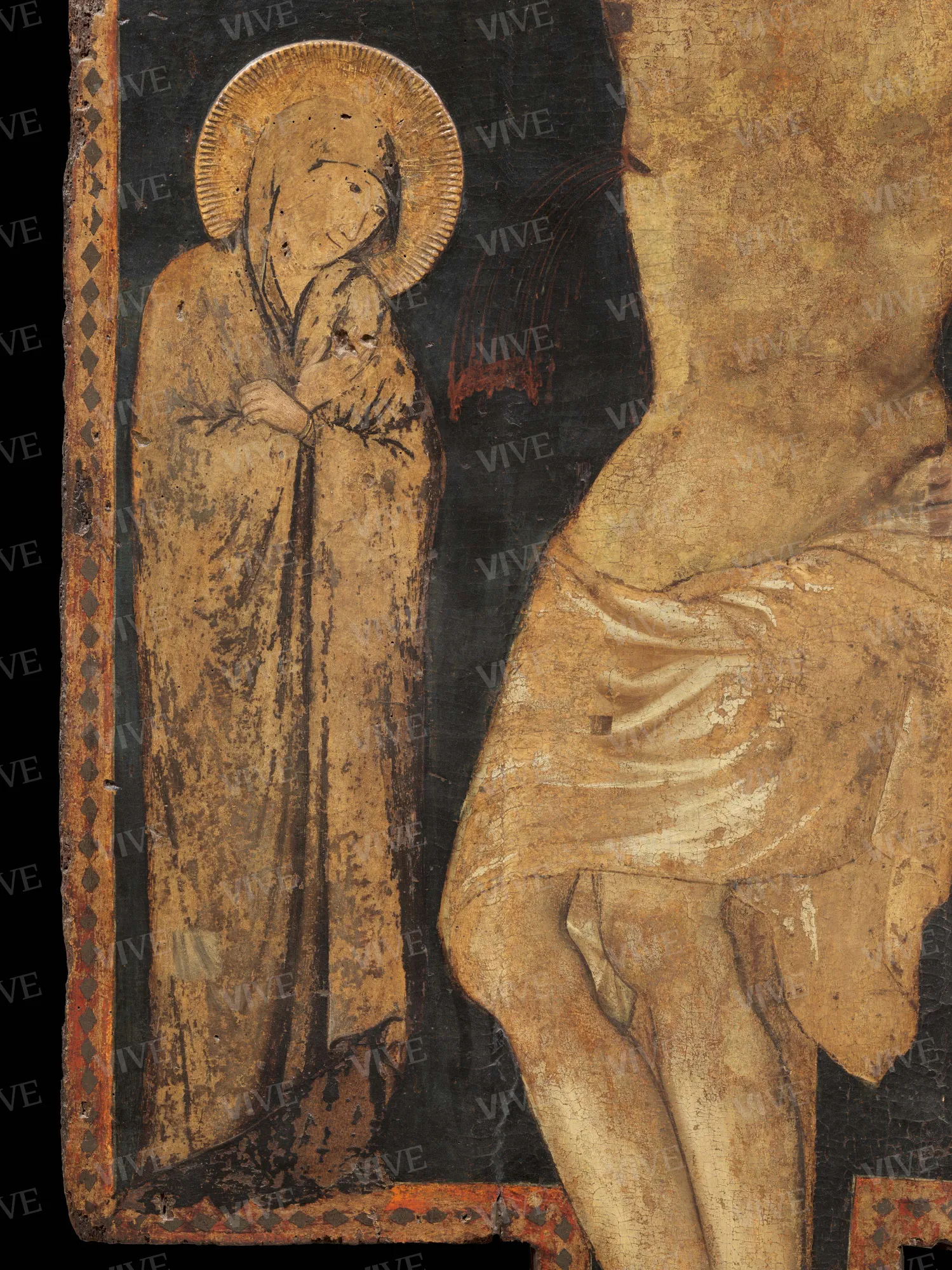Painted cross
Cavallini master Late-13th–early-14th century
This plainly shaped cross is made of elm. It consists of a central panel made up of a rectangular axis, boards, and arms and contains depictions of the crucified Christ, the Virgin, and Saint John the Evangelist. It is crowned by a cymatium in which we can distinguish Christ the Redeemer enthroned between angels and two busts of saints who cannot be identified. Stylistically, it can be framed mainly in relation to what was taking place at the end of the thirteenth century on the scaffolding of the basilica of Saint Francis in Assisi and to Cavallini's endogenous chromaticism.
This plainly shaped cross is made of elm. It consists of a central panel made up of a rectangular axis, boards, and arms and contains depictions of the crucified Christ, the Virgin, and Saint John the Evangelist. It is crowned by a cymatium in which we can distinguish Christ the Redeemer enthroned between angels and two busts of saints who cannot be identified. Stylistically, it can be framed mainly in relation to what was taking place at the end of the thirteenth century on the scaffolding of the basilica of Saint Francis in Assisi and to Cavallini's endogenous chromaticism.
Details of work
Catalog entry
The cross, found by Ilaria Toesca in 1966, was immured and so poorly conserved as to be virtually indecipherable. It was above the right altar of the church of San Tommaso ai Cenci in Rome and most likely came from the church of Santa Maria in Ara Coeli. The piece may have been commissioned by Pietro Colonna (Romano 2006) or Matteo d'Acquasparta (Monciatti 2021). Its discovery was significant as it constitutes one of the most interesting examples of late-thirteenth–early-fourteenth-century Roman artistic production, especially because of how extraordinary its typology is for Rome.
Claudia D'Alberto
Entry published on 12 February 2025
State of conservation
Mediocre. The cross, supported by five different crosspieces, has various gaps at the support level with a large crack at the bottom on the back. Old woodworm damage is still visible. As for the ground and paint layers, there are multiple sections where the paint has detached or blistered. Some of these features have stabilized over time, while others are considered at risk. The paint layer is heavily abraded.
Restorations and analyses
The most important restoration work dates back to 1966, when the work was first discovered. The cross was divested of its substantial repainting, which had probably been carried out around 1881 when the Archconfraternity of Santa Maria del Pianto had the church of San Tommaso "refurbished" (Toesca 1966). In 2009, when it was inspected before being lent to the Giotto e il Trecento exhibition, it was found to be in a parlous state of conservation with gaps in the support, deep cracks on the back, and multiple sections where the preparatory and paint layers had either detached or blistered.
Inscriptions
The cross displays a titulus crucis with the abbreviation "INRI." Fragments of “R” and the final “I” can be made out, although scholars of the work have stated that there are later additions. The titulus must have originally appeared on a cartouche nailed to the vertical beam of the cross.
Provenance
The painted cross originally came from Santa Maria in Aracoeli. According to a memoir by Jacovo delli Cenci transcribed from a seventeenth-century note by Girolamo Cenci and according to Father Casimiro's Memorie Historiche (1736), the work was donated in 1445 by the guardian of the Minor Observant order to the new administrative head of the Ara Coeli, namely Jacopo Cenci, who immediately transferred it to the family church dedicated to Saint Thomas.
Exhibition history
Rome, Musei Capitolini, Palazzo Caffarelli, Dipinti romani tra Giotto e Cavallini, April 8–June 29, 2004;
Rome, Complesso del Vittoriano, Giotto e il Trecento “il piu sovrano maestro stato in dipintura”, March 6–June 29, 2009.
Sources and documents
Memoir of Jacovo delli Cenci transcribed from a seventeenth-century note by Girolamo Cenci—traced by Ilaria Toesca ( 1966, 27–32) in the Archivio Cenci Bolognetti, University of Rome and later merged into the Soprintendenza Archivistica per il Lazio database; Memorie istoriche della Chiesa e Convento di S. Maria in Aracoeli di Roma, collated by Casimiro Romano P.F., Rome 1736.
References
Toesca Ilaria, Una croce dipinta romana, in «Bollettino d’arte», 5.Ser. 51.1966, pp. 27-32;
Tomei Alessandro, Pietro Cavallini, Cinisello Balsamo 2000, pp. 80-84;
Strinati, in Strinati Tommaso, Tartuferi Angelo (a cura di), Dipinti romani tra Giotto e Cavallini, catalogo della mostra (Roma, Musei Capitolini, Palazzo Caffarelli, 8 aprile-29 giugno 2004), Milano 2004, pp. 66-67, n. 6;
Romano Serena , I Colonna a Roma 1288-1297, in Carocci Sandro (a cura di), La nobiltà romana nel medioevo, Rome 2006, pp. 291-312;
D'Alberto, in Tomei Alessandro (a cura di), Giotto e il Trecento "il piu sovrano maestro stato in dipintura", catalogo della mostra (Roma, Complesso del Vittoriano, 6 marzo-29 giugno 2009), Milano 2009, pp. 178-179, n. 22;
Monciatti Alessio, Evidenze e complessità sulla croce dipinta di San Tommaso dei Cenci a Roma, in D’Achille Anna Maria, Iacobini Antonio, Pistilli
Pio Francesco, Domus sapienter staurata. Scritti di storia dell’arte per Marina Righetti, Cinisello Balsamo 2021, pp. 270-281;


